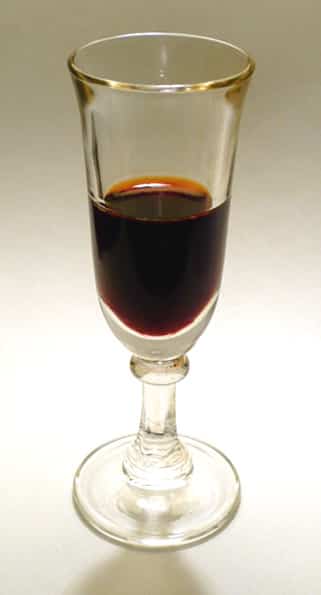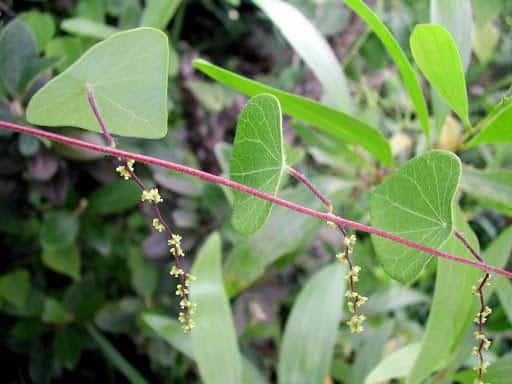A root used in Traditional Chinese Medicine, Stephania Tetrandra benefits include diuresis, kidney protection, anti-inflammation, and diabetes prevention. It is also used as a remedy for:
- Rheumatoid arthritis
- Wet beriberi
- Dysuria
- Eczema
- Inflamed sores
- Warm malaria
- Edema
- Typhoid fever
- Stroke
In the video below, Mei Yi from the Shan Medical Hall gives a quick introductory beginner’s guide to traditional Chinese medicine.
This is our recommended Stephania Root supplement:

What are Stephania Tetrandra’s benefits?
This herb is most commonly used in traditional Chinese medicine to treat joint pain caused by rheumatoid arthritis. However, stephania root benefits include the following effects:
1. Antimicrobial
Tetrandrine shows antimicrobial effects against:
- Parasites
- Bacteria
- Viruses
- Fungi
2. Antiparasitic
Some compounds on S. terandra showed potent activity against the following parasites:
- Plasmodum falciparum, a species of Plasmodium that causes malaria in humans
- Leishmania donovani, a parasite that cause the disease leishmaniasis.
- Echinococcus multilocularis, a small species of tapeworm that produces a disease known as echinococcosis.
3. Antibacterial
Tetrandrine had a positive effect against the following bacteria:
- Staphylococcus aureus, a bacteria that can cause infection on the lungs.
- Mycobacterium tuberculosis, an agent that causes tuberculosis.
4. Antifungal
The antifungal effects of S. tetrandra include:
- Aspergillus fumigatus, a common type of mold spores.
- Candida albicans, a fungus that can cause candidiasis, also known as thrush.
- Athlete’s foot
5. Antiviral
S. tetrandra has shown evidence of having antiviral activity in laboratory tests against the following virus strains:
- HIV laboratory strains
- Herpes simplex virus type-1
- Hepatitis B
- Severe acute respiratory syndrome coronavirus
- Zaire ebola virus
However, the major limitation of these studies is that they were only conducted in laboratory conditions, and further studies are required to assess its antiviral effectiveness.
6. Anti-inflammatory
Many components in S. tetrandra show anti-inflammatory effects through various mechanisms. These results confirm the the traditional use of this plant as a treatment for inflammation.
- Edema (swelling)
- Eczema (red and itchy skin)
- Inflamed wet sores
- Rheumatoid arthritis
- Attenuated cartilage degradation, preventing the progression of osteoarthritis.
7. Anticancer
10 clinical trials used Radix Stephaniae Tetrandrine in combination with other herbs to treat breast cancer. However, most of the clinical trials about breast cancer treatment had poor design, small patient samples, and different combinations of herbs prescribed.
Alkaloids in S. tetrandra showed favorable anti-tumor activities by:
- Targeting reversing multidrug resistance
- Inhibiting cell proliferation
- Inducing apoptosis (programmed cell death)
- Preventing tumor angiogenesis (formation of new blood vessels)
- Anti-oxidation
- Anti-inflammation
- Diminishing radiotherapy toxicity
8. Neuroprotective
In experiments with rats, stephania compounds are shown to be protective against the effects of:
- Alzheimer’s disease.
- Parkinson’s disease.
- Seizures frequency.
- Long-term memory impairment.
- Cocaine seeking, in a dose-dependent manner, and significantly decreased breakpoints for cocaine reward.
9. Sleep enhancing
In mice, Tetrandrine has been shown to improve sleep by increasing total sleep time, rapid eye movement (REM) sleep and non-REM sleep, (deep sleep and light sleep).
10. Pain relief
This herb has been shown to reduce the production of pain mediators in mice. However, further research are needed to confirm this activity in humans.
11. Cardiovascular
Tetrandrine has antihypertensive and antiarrhythmic effects demonstrated in animals and in hypertensive patients. These effects are generated through a calcium blocking effect.
- Ischemic heart diseases
- Arrythmia
- Hypertension
- Intraocular pressure
- Myocardial infarction induced by ischemia
- Wet beriberi
12. Antifibrotic
Tetrandrine has been approved in China for the treatment of silicosis. S. tetrandra extracts have been shown to effectively prevent and reverse hepatic fibrosis in rats. Tetrandrine was shown to reverse human myocardial fibrosis through calcium blocking. Tetrandrine exhibited a synergistic effect when used with prednisone for renal fibrosis caused in rats.
- Liver ascites
- Cough
- Asthma
- Pulmonary fibrosis
- Silicosis (inhaling silica particles)
- Hepatic fibrosis
13. Antidiabetic
Compounds found in S. Tetrandra reduced elevated blood glucose and also increased low blood insulin in diabetic mice.
14. Urinary system
- Enuresis (inability to control urination)
- Astringent urine (ammonia smell)
- Dysuria (pain when urinating)
- Diuretic
15. Miscellaneous uses
- Prevention and treatment of noise-induced hearing loss.
- Anti-adipogenic effects (prevents generation of fat cells).
- Prevented bone loss in mice.
What are Stephania root’s side effects?
Stephania root side effects may include:
- Widening of blood vessels (vasodilation)
- Low blood pressure
- Constipation
- Tachycardia (fast heartbeat)
- Palpitations
- Headache
- Edema (swelling)
Stephania root side effects are not frequent and are well tolerated, when consumed in the recommended dosages.
Tetrandrine should not be used alongside other calcium channel blockers or beta blockers, since these also affect blood pressure, and may cause atrioventricular block and arrhythmia.
After injecting a single large dose of 150 mg/kg tetrandrine to mice, stephania root side effects included toxicity to the lungs, kidneys, and liver, it also showed carcinogenic effects. Therefore, a safe dose of tetrandrine for humans still needs to be evaluated. It is not suitable for long-term use in large doses.
Due to similarity in the use of their common names, Stephania tetrandra (“hang fang ji”) might be mistakenly substituted or adulterated with Aristolochia fangchi (“guang fang ji”), which has potentially dangerous side effects. At least four different plants are commonly referred to as “fang ji”, including:
| Pin Yin (chinese) name | Botanical name |
|---|---|
| Guang Fang Ji | Aristolochia fangchi |
| Han Fang Ji | Stephania tetrandra |
| Mu Fang Ji | Cocculus trilobus |
| Mu Fang Ji | Cocculus orbiculatus |
| Fang Ji | Sinomenium acutum |
A. fangchi contains aristolochic acid, a carcinogen that causes urothelial (urinary system) cancer as well as aristolochic acid nephropathy (damage to the blood vessels of the kidneys).
What is Stephania Tetrandra’s common name?
Below are listed all known stephania tetrandra common names:
- Common name: Stephania root, Stephania Tetrandra
- Dried root part name: Radix Stephaniae Tetrandrine (RST)
- Chinese (Pinyin) common name: Fang Ji, Guang Fang Ji, Mu Fang Ji, Han Fang Ji
- Chinese (Pinyin) root part name: Fen Fang Ji
- Chinese (Pinyin) name translation: 防己, “snakebite remedy”
- Botanical name: Stephania Tetrandra S. Moore. Spencer Le Marchant Moore (an English botanist who lived from November 1st 1850 to March 14th 1931) was the first botanist to catalog this herb. The standard author abbreviation S.Moore is used to indicate this person as the author.
Stephania root tincture

Stephania root tincture is a concentrated liquid form of the root part of the Stephania herb. It is made by soaking the roots into a mix of water and alcohol. The alcohol in this soaking process extracts the not water-soluble active components of the stephania root, such as alkaloids and resins. It can be prepared manually at home, for those who prefer to get stephania tetrandra benefits in liquid form.
How to prepare a Stephania root tincture?
The basic steps for creating a tincture include the following:
- Purchase or gather the Stephania root
- Wash and chop the roots
- Prepare the liquid. The liquid should be made of alcohol and water. The water to alcohol ratio should be one part of water and two parts of alcohol. You may use 180-proof alcohol
- The root to liquid ratio should be one part of root and five parts of liquid.
- Put the roots in an airtight jar
- Fill the jar with this liquid
- Seal the jar for 6 or more weeks. This is enough time for the alcohol to absorb the active components of the stephania root.
- Shake the jar for a minute once each day
It is advised to include a label in the jar, with basic information like:
- Jar creation date
- Common name (Stephania root)
- Whether the root was fresh or dried
- Concentration of the alcohol used
- Instructions for tincture usage
How to take a Stephania root tincture?
- Open the jar
- Separate the root parts from the liquid mix
- Use a small dropper (contains 20 drops)
- Try not to take more than 2 full small droppers (40 drops)
- Drip the drops under the tongue
- Hold the drops under the tongue for a few seconds
- Swallow the drops
- Rinse the mouth with water
Want to know more?
Click the links below to access the individual topic pages:
Sources
This article makes use of information from the U.S. National Library of Medicine under the terms of the Creative Commons Attribution 4.0 International License.
- Sekiya N, Shimada Y, Niizawa A, et al. Suppressive effects of Stephania tetrandra on the neutrophil function in patients with rheumatoid arthritis. Phytother Res. 2004;18(3):247-249. doi:10.1002/ptr.1396
- Joshi VC, Avula B, Khan IA. Authentication of Stephania tetrandra S. Moore (Fang Ji) and differentiation of its common adulterants using microscopy and HPLC analysis. J Nat Med. 2008;62(1):117-121. doi:10.1007/s11418-007-0200-5
- Jiang Y, Liu M, Liu H, Liu S. A critical review: traditional uses, phytochemistry, pharmacology and toxicology of Stephania tetrandra S. Moore (Fen Fang Ji) [published online ahead of print, 2020 Apr 24]. Phytochem Rev. 2020;1-41. doi:10.1007/s11101-020-09673-w
- Zhang Y, Qi D, Gao Y, et al. History of uses, phytochemistry, pharmacological activities, quality control and toxicity of the root of Stephania tetrandra S. Moore: A review. J Ethnopharmacol. 2020;260:112995. doi:10.1016/j.jep.2020.112995
- Guo Y, Chen B, Pei X, Zhang D. Radix Stephaniae Tetrandrine: An Emerging Role for Management of Breast Cancer. Curr Pharm Des. 2020;26(1):25-36. doi:10.2174/1381612826666200110143706
- Wong TM, Wu S, Yu XC, Li HY. Cardiovascular actions of Radix Stephaniae Tetrandrae: a comparison with its main component, tetrandrine. Acta Pharmacol Sin. 2000;21(12):1083-1088.
- Wang R, Ma TM, Liu F, Gao HQ. Zhongguo Zhong Yao Za Zhi. 2017;42(4):634-639. doi:10.19540/j.cnki.cjcmm.20170121.024
- Walden R, Tomlinson B. Cardiovascular Disease. In: Benzie IFF, Wachtel-Galor S, editors. Herbal Medicine: Biomolecular and Clinical Aspects. 2nd edition. Boca Raton (FL): CRC Press/Taylor & Francis; 2011. Chapter 16. Available from: https://www.ncbi.nlm.nih.gov/books/NBK92767/
- IARC Working Group on the Evaluation of Carcinogenic Risk to Humans. Some Traditional Herbal Medicines, Some Mycotoxins, Naphthalene and Styrene. Lyon (FR): International Agency for Research on Cancer; 2002. (IARC Monographs on the Evaluation of Carcinogenic Risks to Humans, No. 82.) B, Aristolochia species and aristolochic acids. Available from: https://www.ncbi.nlm.nih.gov/books/NBK326609/
- https://www.ncbi.nlm.nih.gov/pmc/articles/PMC7180683/

